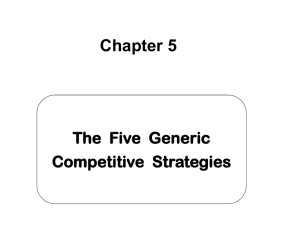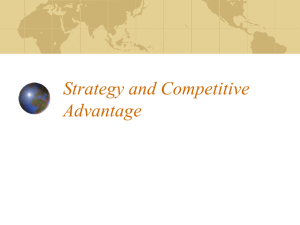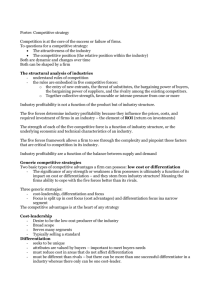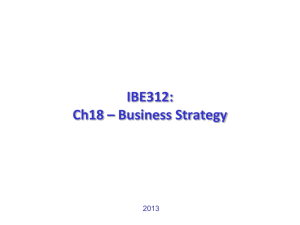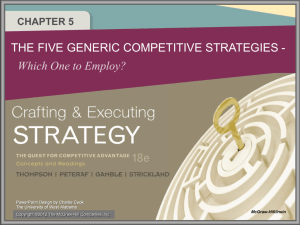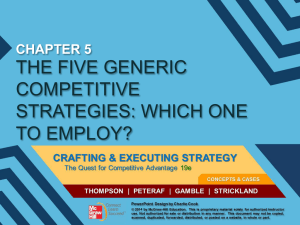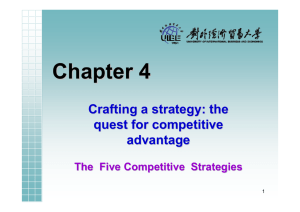Essentials of Strategic Management 4e
advertisement
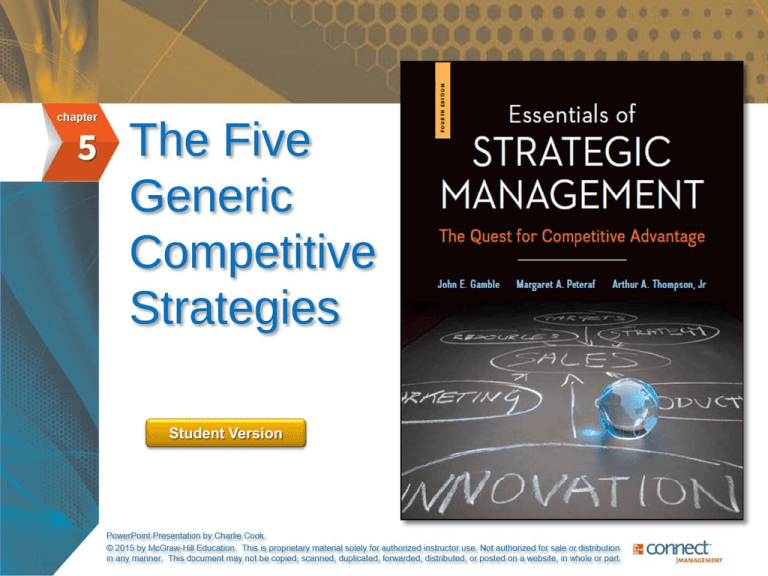
Student Version Competitive Strategies and Market Positioning • Competitive Strategy Deals exclusively with management’s game plan for competing successfully and securing a competitive advantage over rivals Represents the firm’s specific efforts to provide superior value to customers by offering: An equally good product at a lower price A superior product with unique features perceived as worth paying more for An attractive overall mix of price, features, quality, service, and other appealing attributes 5-2 The Five Generic Competitive Strategies Low-cost provider Broad differentiation Striving to achieve lower overall costs than rivals and appealing to a broad spectrum of customers, usually by underpricing rivals Seeking to differentiate the firm’s product or service from rivals’ in ways that will appeal to a broad spectrum of buyers Focused low-cost Concentrating on a narrow buyer segment (or market niche) and outcompeting rivals by having lower costs than rivals and thus being able to serve niche members at a lower price Focused differentiation Concentrating on a narrow buyer segment (or market niche) and outcompeting rivals by offering niche members customized attributes that meet their tastes and requirements better than rivals’ products Best-cost provider Giving customers more value for the money by satisfying buyers’ expectations on key quality/features/performance/service attributes while beating their price expectations 5-3 Low-Cost Provider Strategies • A powerful competitive approach with pricesensitive buyers when a firm’s offering: Has a lower cost than rivals—but not necessarily the absolutely lowest possible cost. Includes features and services that buyers consider essential. Is viewed by buyers as offering equivalent or higher value even if priced lower than competing products. 5-4 Translating a Low Cost Strategy Into Attractive Profit Performance Option 1 Use a lower-cost edge to underprice competitors and attract price-sensitive buyers in great enough numbers to increase total profits Option 2 Maintain present price, be content with present market share, and use lower-cost edge to earn a higher profit margin on each unit sold 5-5 The Two Major Avenues for Achieving Low-Cost Leadership 1. Perform essential value chain activities more cost-effectively than rivals. 2. Revamp the firm’s overall value chain to eliminate or bypass some cost-producing activities altogether. 5-6 Revamping the Value Chain Reengineering the firm’s value chain Sell directly to consumers and cut out the activities and costs of distributors and dealers Streamline operations by eliminating low value-added or unnecessary work steps and activities Collaborate with suppliers to improve supply chain efficiency by reducing materials handling, shipping and inventory costs 5-7 When a Low Cost Strategy Works Best 1. Price competition among rival sellers is especially vigorous. 2. The products of rival sellers are essentially identical and are readily available from several sellers. 3. There are few ways to achieve product differentiation that have value to buyers. 4. Buyers incur low costs in switching their purchases from one seller to another. 5. The majority of industry sales are made to a few, largevolume buyers. 6. Industry newcomers use introductory low prices to attract buyers and build a customer base. 5-8 Pitfalls to Avoid in Pursuing a Low-Cost Provider Strategy 1. Overly Aggressive Price Cutting Price cutting results in lower margins, no increase in sales volume and lower profitability 2. Relying on easily imitated cost reductions 3. Becoming too fixated on cost reduction Ignoring buyer interest in additional features Overlooking declining buyer sensitivity to price Technological breakthroughs nullify cost advantages 5-9 Broad Differentiation Strategies • Attractive competitive approaches to use whenever buyers’ needs and preferences are too diverse to be fully satisfied by a standardized product or service. Involves offering differentiating features that clearly set the firm’s products or services apart from rivals. Enhances profitability whenever the extra price the product commands outweighs the added costs of achieving the differentiation that is not easily copied or matched by rivals. 5-10 Benefits of Successful Differentiation Successful execution of a differentiation strategy allows a firm to: Command a premium price Increase its unit sales Gain buyer loyalty to its brand 5-11 Revamping the Value Chain to Increase Differentiation Approaches to enhancing differentiation through changes in the value chain system Coordinating with downstream channel allies to enhance customer value Coordinating with upstream suppliers to better address customer needs 5-12 Delivering Superior Value via a Differentiation Strategy 1. Include product attributes and user features that lower the buyer’s costs. 2. Incorporate tangible features that improve product performance 3. Incorporate intangible features that enhance buyer satisfaction in noneconomic ways. 5-13 Perceived Value and the Importance of Signaling Value • A differentiation strategy’s price premium reflects value actually delivered to the buyer and value perceived by the buyer. • It is important to signal value when: The nature of differentiation is subjective When buyers are making first-time purchases When repurchase is infrequent When buyers are unsophisticated 5-14 Value Chain Activities That Enhance Differentiation Manufacturing activities Supply chain activities Product R&D Production R&D and technologyrelated activities Activities that Enhance Differentiation Distribution and shipping activities Marketing, sales, and customer service activities 5-15 When a Differentiation Strategy Works Best 1. Buyer needs and uses of the product are diverse. 2. There are many ways to differentiate the product or service that have value to buyers. 3. Few rival firms are following a similar differentiation approach. 4. Technological change is fast-paced and competition revolves around rapidly evolving product features. 5-16 Pitfalls to Avoid in Pursuing a Differentiation Strategy • Pursuing a differentiation strategy keyed to product or service attributes that are easily and quickly copied. • Incorporating product features or attributes in which buyers see little value or are easily copied by rivals. • Overspending on efforts to differentiate that erode profitability. • Over-differentiating so that product quality or service levels exceed buyers’ needs. • Trying to charge too high a price premium. • Not establishing meaningful gaps in quality or service or performance features over the products of rivals. 5-17 Focused (or Market Niche) Strategies • Are strategies developed especially for competing in a narrow piece of the total market as defined by geographic uniqueness or special product attributes. • Are appealing to smaller and medium-sized firms that may lack the breadth and depth of resources to tackle going after a whole market customer base. 5-18 A Focused Low-Cost Strategy • Aims at securing a competitive advantage by serving buyers in the target market niche at a lower cost and a lower price than rival competitors. • Achieves its cost advantage in the same way as for low-cost leadership—by outmanaging rivals in keeping costs low and bypassing or reducing nonessential activities. 5-19 Focused Differentiation Strategy • Keyed to offering carefully designed products or services to appeal to the unique preferences and needs of a narrow, well-defined group of buyers (as opposed to a broad differentiation strategy aimed at many buyer groups and market segments). 5-20 When a Focused Low-Cost or Focused Differentiation Strategy Is Viable • The target market niche is big enough to be profitable and offers good growth potential. • Industry leaders have chosen not to compete in the niche— focusers can avoid battling head-to-head against the industry’s biggest and strongest competitors. • It is costly or difficult for multisegment competitors to meet the specialized needs of niche buyers and at the same time satisfy the expectations of mainstream customers. • The industry has many different niches and segments, thereby allowing a focuser to pick a niche suited to its resource strengths and capabilities. • Few, if any, rivals are attempting to specialize in the same target segment. 5-21 The Risks of a Focused Low-Cost or Focused Differentiation Strategy 1. Competitors will find effective ways to match a focuser’s capabilities in serving the target niche. 2. The preferences and needs of niche members to shift over time toward the product attributes desired by the majority of buyers. 3. The segment may become so attractive it is soon inundated with competitors, intensifying rivalry and splintering segment profits. 5-22 Best-Cost Provider Strategies • Are a hybrid of low cost provider and differentiation strategies that: Involves giving customers more value for money by satisfying buyer expectations on key quality/features/ performance/service attributes while exceeding customer expectations on price. Is a powerful competitive approach with value- conscious buyers looking for a good-to-very-good product or service at an economical price. Create a “best-cost” status as the low-cost provider of a product or service with upscale attributes. 5-23 Employing Best-Cost Strategies • Profitable best-cost strategies are contingent on: 1. A superior value chain configuration that eliminates or minimizes activities that do not add value. 2. Unmatched efficiency in managing essential value chain activities. 3. Core competencies that allow differentiating attributes to be incorporated at a low cost. 5-24 When a Best-Cost Provider Strategy Works Best • A best-cost provider strategy works best in markets where: Product differentiation is the norm. Large numbers of value-conscious buyers can be induced to purchase economically-priced mid-range products and services, especially during recessionary times. A provider can offer either a medium-quality product at a below-average price or a high-quality product at an average or slightly higher-than-average price. 5-25 The Danger of an Unsound Best-Cost Provider Strategy • Losing at both ends of the market: Dual vulnerability to both low-cost providers and high- end differentiators in not having the requisite core competencies and efficiencies in managing value chain activities to offer significantly differentiating product attributes or features at attractive lower prices without significantly increasing costs. 5-26 Successful Competitive Strategies Are Resource Based • Low-Cost Providers Must have the resources and capabilities to keep their costs below those of their competitors. Must have expertise to cost-effectively manage value chain activities better than rivals. • Differentiators Must have the resources and capabilities to incorporate unique attributes that a broad range of buyers will find appealing and worth paying for. 5-27 Successful Competitive Strategies Are Resource Based (cont’d) • Narrow Segment Focusers Must have the capability to do an outstanding job of satisfying the needs and expectations of niche buyers. • Best Cost Providers Must have the resources and capabilities to incorporate upscale product or service attributes at a lower cost than rivals. 5-28
